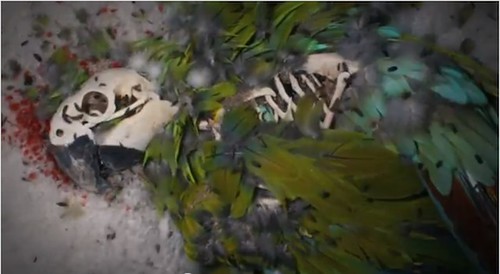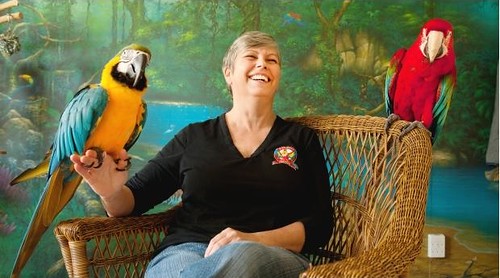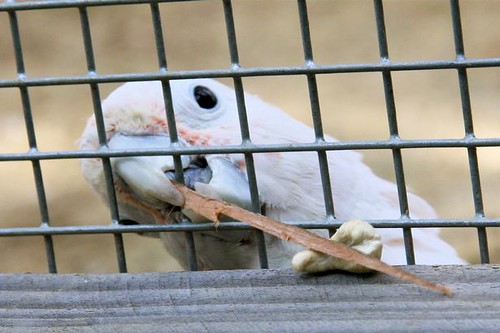Parrot chicks rescued from poachers in Brazil
 Monday, November 12, 2012 at 8:47
Monday, November 12, 2012 at 8:47 So far this year police in Brazil have rescued almost 14,000 illegally captured wild animals.
 Monday, November 12, 2012 at 8:47
Monday, November 12, 2012 at 8:47 So far this year police in Brazil have rescued almost 14,000 illegally captured wild animals.
 Friday, November 9, 2012 at 12:39
Friday, November 9, 2012 at 12:39  Military Macaw being devoured by flesh-eating beetles.Sometimes skin, feathers and the more fleshy parts of an animal are just in the way of the part that we need to study. So how do museums get nice clean skeletal specimens? Some museums use harsh chemicals, like hydrogen peroxide and carbon tetrachloride, to eat away the flesh — but this technique can cause damage to the bones as well as molecular changes. The Natural History Museum in London has found a greener solution: flesh-eating beetles.
Military Macaw being devoured by flesh-eating beetles.Sometimes skin, feathers and the more fleshy parts of an animal are just in the way of the part that we need to study. So how do museums get nice clean skeletal specimens? Some museums use harsh chemicals, like hydrogen peroxide and carbon tetrachloride, to eat away the flesh — but this technique can cause damage to the bones as well as molecular changes. The Natural History Museum in London has found a greener solution: flesh-eating beetles.
 Ara militaris - Military Macaw | in
Ara militaris - Military Macaw | in  Research
Research  Friday, November 9, 2012 at 2:13
Friday, November 9, 2012 at 2:13  Tuesday, November 6, 2012 at 13:38
Tuesday, November 6, 2012 at 13:38  Most of the birds Judy Tennant rescues — she currently has 15 — are the result of well-meaning owners who discover too late the enormous commitment required of having a parrot. Photograph by: Bruce DeachmanOTTAWA — Judy Tennant literally wears the trials of her profession on her sleeve. Her arms and hands are scarred by the claws and beaks of the parrots she’s rescued, and she’s twice been sent to the emergency ward of the hospital by Sinbad, a Green-winged macaw in her care that arrived with nasty aggression issues.
Most of the birds Judy Tennant rescues — she currently has 15 — are the result of well-meaning owners who discover too late the enormous commitment required of having a parrot. Photograph by: Bruce DeachmanOTTAWA — Judy Tennant literally wears the trials of her profession on her sleeve. Her arms and hands are scarred by the claws and beaks of the parrots she’s rescued, and she’s twice been sent to the emergency ward of the hospital by Sinbad, a Green-winged macaw in her care that arrived with nasty aggression issues.
 Monday, November 5, 2012 at 10:01
Monday, November 5, 2012 at 10:01  Who's a clever boy: Figaro uses a twig to fetch a nutFigaro may not be as talented an inventor as Leonardo da Vinci, but among Goffin's cockatoos, he's a prodigy. In their natural habitat—the forests of Indonesia these cockatoos have never been seen making or using tools. But researchers report today—that Figaro, a member of a captive colony of the birds in Austria, invents and uses stick tools of his own design. Although toolmaking and use is not uncommon in animals, this type of spontaneous innovation and individual creativity is "exceedingly rare" among nonhuman animals, the scientists note, and opens up many questions about the cognitive skills required. Understanding these processes, they say, may help unlock many of the questions about the evolution of intelligence.
Who's a clever boy: Figaro uses a twig to fetch a nutFigaro may not be as talented an inventor as Leonardo da Vinci, but among Goffin's cockatoos, he's a prodigy. In their natural habitat—the forests of Indonesia these cockatoos have never been seen making or using tools. But researchers report today—that Figaro, a member of a captive colony of the birds in Austria, invents and uses stick tools of his own design. Although toolmaking and use is not uncommon in animals, this type of spontaneous innovation and individual creativity is "exceedingly rare" among nonhuman animals, the scientists note, and opens up many questions about the cognitive skills required. Understanding these processes, they say, may help unlock many of the questions about the evolution of intelligence.